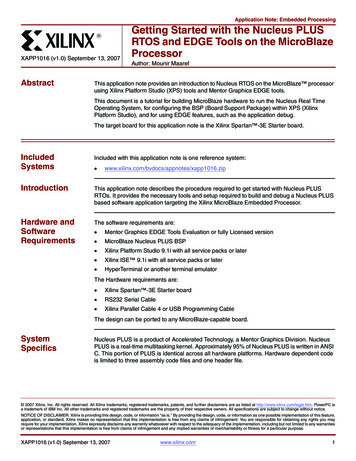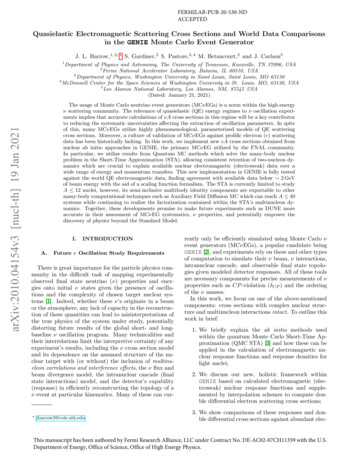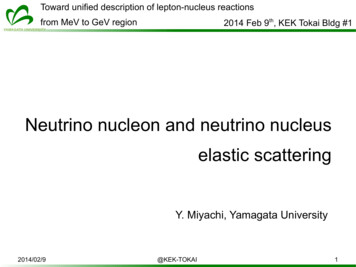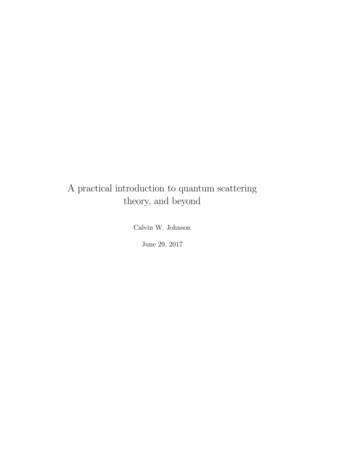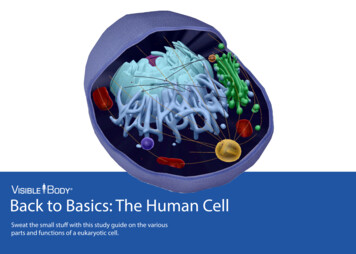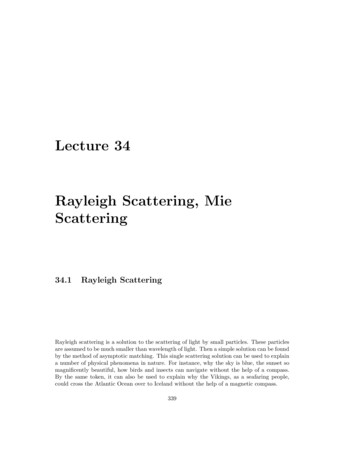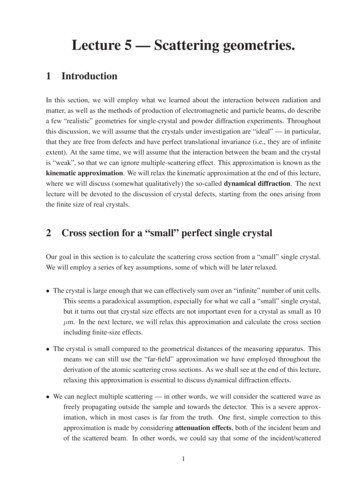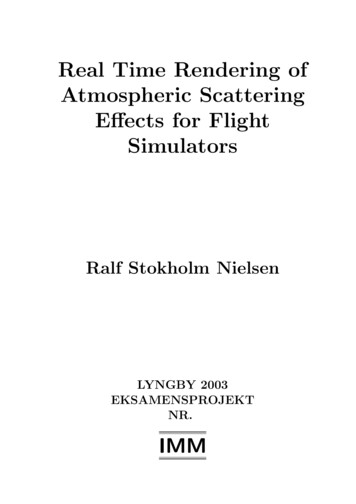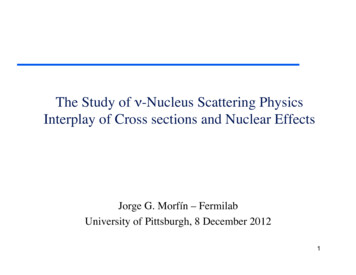
Transcription
The Study of ν-Nucleus Scattering Physics Interplay of Cross sections and Nuclear Effects Jorge G. Morfín – FermilabUniversity of Pittsburgh, 8 December 20121
ν – H / D ScatteringLife was simpler when our targets were nucleonsas opposed to nuclei.Contemporary neutrino (oscillation) experiments demandhigh statistics massive nuclei as targets.Jorge G, Morfín - Fermilab2
Neutrino Nucleus Scattering What do we observe in our detectors?3
Neutrino Nucleus Scattering appearance of νedistance 1300kmWhat do we observe in our detectors?Jorge G, Morfín - Fermilab4
Neutrino Nucleus Scattering What do we observe in our detectors?NeutrinoAnti-neutrinoJ.A. Formaggio and G.P. Zeller, Rev. Mod. Phys., 2012.Jorge G, Morfín - Fermilab5
Neutrino Nucleus Scattering What do we observe in our detectors?Jorge G, Morfín - Fermilab6
What are these Nuclear Effects Nucc,d,e. c (Εʼ Ε)in Neutrino Nucleus Interactions? Target nucleon in motion – classical Fermi gas model or thesuperior spectral functions (Benhar et al.) Certain reactions prohibited - Pauli suppressionMeson exchange currents: multi-nucleon initial states Form factors are modified within the nuclear environment.(Butkevich / Kulagin, Tsushima et al.) Produced topologies are modified by final-state interactionsmodifying topologies and possibly reducing detected energy. Convolution of δσ(nπ) x formation zone uncertainties x π-charge-exchage/absorption Cross sections and structure functions are modified and partondistribution functions within a nucleus are different than in anisolated nucleon. Important for DIS AND Transition region events!7
Target Nucleon in Motion – Classical Fermi GasModel or the Superior Spectral Functions Impulse Approximation (IA) – nucleus treated as a collection ofindependent nucleons – no collective excitations In the IA the nucleus is fully described by its spectral function breaks down as Q decreases with spatial resolution decreasing as 1/QThe spectral function gives the distribution of momenta and energies of thenucleons inside the nucleusThe original model to describe this distribution is the Fermi Gasmodel8Jorge G, Morfín - Fermilab
Spectral Function Approach Superior – Particularly as Q DecreasesArtur AnkowskiNuInt09Jorge G, Morfín - Fermilab9
Final State Interactions (FSI) Components of the initial hadron shower interact within the nucleuschanging the apparent final state configuration and even the detectedenergy.For example, an initial pion can charge exchange or be absorbed ona pair of nucleons and an initial nucleon can scatter producing a pionExample numbersFinal µ pFinal µ p πInitial µ p90%10%Initial µ p π25%75%Jorge G, Morfín - Fermilab10
Attempt to Remove Resonance Background MiniBooNE Experiment exampleEvent generator – a particular model - is used to remove QE-likebackground (pion absorption) from QE-like Xsect (blue) yieldingan extracted QE Xsect (red) large pion absorption modeldependence of QE result.Jorge G, Morfín - Fermilab11
Nuclear Effects can Change the Energy Reconstruction for “QE” Events In pure QE scattering on nucleon at rest, the outgoing leptoncan determine the neutrino energy:Since all modern experiments2012NUFACTcontain nuclei as targets.Reconstructed energy shifted tolower energies for all processes other than true QEJorge G, Morfín - FermilabU. Mosel GiBUU12
Experimental Studies of (Parton-level) Nuclear Effects with Neutrinos: until recently - essentially NON-EXISTENT1.2EMCNMCE139E6651.11Fermi motion0.90.8shadowing0.70.0010.01sea quarkEMC effectx0.11valence quark F2 / nucleon changes as a function of A. Specifically measured in µ/e - A not in ν - Α Good reason to consider nuclear effects are DIFFERENT in ν - A. Presence of axial-vector current.SPECULATION: Stronger shadowing for ν -A but somewhat weaker “EMC”effect.Different nuclear effects for valance and sea -- different shadowing for xF313compared to F2.
F2 Structure Function Ratios: ν-Iron nCTEQ CollaborationF2(ν Fe)F2(ν [n p])14
What do we observe in our detectors?effective σcΑ(Ε)15
Range of Existing Model (MC) Predictions off C NuInt09 – Steve DytmanJorge G, Morfín - Fermilab16
Significant Implications for Oscillation Experiments Can not simply plug in effective σπ0C from experiments in asignificantly different beam.In a two-detector oscillation experiment the neutrino flux enteringthe far detector is altered from the neutrino flux at the near detectordue to oscillations.The σcΑ (E) effective that should be applied to expectations (MonteCarlo) at the far detector is NOT the same as that which we wouldmeasure at the near detector.The convoluted σ(Ε) X Nuc(E’ E) effects do not “simplycancel” near and far. However, the near detector results giveus an excellent starting point for calculating the difference.Jorge G, Morfín - Fermilab17
Don’t Forget νe and νe Cross Sections M.Day: ?contribId 231&confId 0 S. Zeller: d 5824 What do we know about σνe(Ε)? Mostly very low energy results. Reactor neutrinos studying Inverse Beta DecaySolar neutrino off deuterium (SNO)Stopping π/µ decay neutrinos off higher A targetsSee Formaggio and Zeller Rev. Mod. Phys. 84, 1307–1341 (2012).One of few measurements of spectral shape of σ reflects the upper limit ofmost existing measurements, E 50 MeV.Jorge G, Morfín - Fermilab18
What do we know about σνe(Ε)? Need to measure the σe(E) of multiple channels to predictspectrum at the far detector. Want an intense source of νe events.Would like to know the flux of νe (and νµ, by the way) to order 1%.σµ(E)19
What do we know about σνe(Ε)? Need to measure the σe(E) of multiple channels to predictspectrum at the far detector. Want an intense source of νe events.Would like to know the flux of νe (and νµ, by the way) to order 1%.σµ(E)σe(E)2020
What are the Differences σνµ(Ε) and σνe(Ε)? Quasi-elastic Scattering Day-McFarland study: Phys.Rev. D86 (2012) 053003 QE scattering dominates at low energies (2nd oscillation maxima)Sources of possible differences and uncertainties - obvious: Kinematic limits from µ / e mass difference.Radiative Corrections. This may be an overestimate. Need full calculation.(σµ-σe)/σe νeradiative correctionsνµ(M. Day, K. McFarland, arXiv:1206.6745)21
What are the Differences? Mainly QE Scattering Due to Nuclear Effects For standard models, 5% differences on νe/νµ ratio E 200 MeV(superscaling/Fermi Gas)(spectral function/Fermi Gas)νe/νµ ratioνe/νµ ratio22stay tuned!S. Zeller: νSTORM Workshop22
What are the Differences? Mainly QE Scattering Meson-exchange Current Contributions – Marco Martini via S. Zeller Hadronic part (nuclear response functions) is the same for νe or νµ cross section.However, the lepton tensor changes the relative weight of the nuclearresponses in the several channels may change.The double ratio suggests the effect on the νe/νµ cross section ratio is 5% (S.Zeller)23
What are the Differences? Δ Production Paschos – Schalla: arXiv:1209.4219 Manny and his student have investigated νµ and νµ differences in Δ production inthe low-Q region where PCAC dominates the axial contribution.At E 1-2 GeV, V part and V/A interference same size cancel for νUse the Adler-Nussinov-Paschos model for nuclear corrections.24
What are the Differences? Δ Production Paschos – Schalla: arXiv:1209.4219 Paschos-Schalla predicts the following differences in cross sectionswhere only the lepton mass term contributions are shown and anydifferences in form factors are not yet included.νe solidνµ dashed25
Can we Actually MEASURE these Differences in the 0.5 – 4 GeV region νSTORM Neutrinos from Stored MuonsHigh-Precision ν interaction physics program. The νSTORM beam will provide avery well-known (δ φ(E) 1%) beamof ν and ν. νe and νe cross-section measurements. νµ and νµ cross-section measurementsAddress the large Δm2 oscillation regime, make amajor contribution to the study of sterile neutrinos. Either allow for precision study (in manychannels), if they exist in this regime. Or greatly expand the dis-allowed region.Provide a µ decay ring test demonstration and µ beam diagnostics test bed.Provide a precisely understood ν beam for detector studies.Change the conception of the neutrino factory. 26
The νSTORM Neutrino Beam µ νµ νe e µ- νµ νe e- A high-intensity source of νe events for experiments.νeνµ3.8 GeV µ stored, 150m straight, flux at 100m(thanks to Sam Zeller and Chris Tunnell!)µ µ-event rates per 1E21 POT 100 tons at 50m27
νe Event Fractions in νSTORM νe produced by 3.8 GeV µ beam.νe CC eventstotal CCRESQEDISout of theCC modes:* 56%resonant* 32% QE* 12% DIStrue Eν (GeV) For νe sample, 52% resonant, 40% QE, 8% DIS)28
Summary and Conclusions Nuclear effects, present in the data of all contemporary neutrinooscillation experiments, mixes channels and changes energy betweenproduced and final states (observed).Observed results for a specific channel from one detector does nottransfer to another detector unless they are using the same neutrinobeam. What is a “standard candle”?Need to study these effects on a variety of nuclear targets and with avariety of incoming neutrino energy distributions.A significant step forward would be a high-statistics neutrinohydrogen /deuterium experiment to untangle these effects.νe Cross sections are also important for future oscillation studies.Best would be a neutrino beam with a flux that we know to 1%Combine the needs A high precision cross section experiment both29for νµ & νe. nuSTORM
BackupJorge G, Morfín - Fermilab30
What could MINERνA Contribute? Preliminary Predictions for MINERνA TargetsPreliminaryl -APreliminaryCombined(poor) fitν–APreliminaryCareful! Based on analysis of NuTeVν-Fe results and scaled in A as chargedlepton nucleus scattering results!(Karol Kovarik – Katlsruhe)31
A More-Detailed Look at Differences NLO QCD calculation of in the ACOT-VFN schemecharge lepton fit undershoots low-x data & overshoots mid-x datalow-Q2 and low-x data cause tension with the shadowing observed incharged lepton data32
A More-Detailed Look at Differences NLO QCD calculation of in the ACOT-VFN schemecharge lepton fit undershoots low-x data & overshoots mid-x datalow-Q2 and low-x data cause tension with the shadowing observed incharged lepton data33
Muon Tracking x Matching εWhy not 100%?* big shower* pileup* deadtimedataMC νµ CCoverlaid with dataJorge G, Morfín - Fermilab34
Fermi Gas vs. Spectral Function p Distribution Bodek – Ritchie adds high p tail to FG due to SRCArtur AnkowskiNuInt09Jorge G, Morfín - Fermilab35
F2 Structure Function Ratios: ν-IronF2(ν Fe)F2(ν [n p])36
Final State Interactions can mimic a QE event Define a class of events as “QE-like” that have the apparenttopology but can have been produced as something other thanQE.Jorge G, Morfín - Fermilab37
MiniBooNE Measurement of MA: Much HigherJorge G, Morfín - Fermilab38
QE and QE-like eventsM.MartiniNuFact09Jorge G, Morfín - Fermilab39
Meson Exchange Currents – 2p2h Effects CCQE and CCQE-likeJorge G, Morfín - Fermilab40
Why are νeCross Sections Important? νe A – scattering results are interesting on their own.Recent determination of large θ13 has opened up possibilities of Determining ν mass ordering.Searching for CP-violation in the ν sector.To be sensitive to these effects, current/near-future long-baselineexperiments will be looking for νµ to νeand νµ to νe oscillations over a range ofS. Parkeenergies. These will no longer be only “counting”CP effectlargestexperiments but rather will depend onMH effectobserving distortions in the far detectorslargestneutrino energy spectrum in both neutrino41and anti-neutrino samples.appearance of νedistance 1300km
Why are νe and νe Cross Sections Important? Large θ13 means we could havereasonable statistics.However, as the now-well-knownplot at right suggests, theasymmetry between ν and ν willbe small and the goal ofconstraining the range of δ willdemand minimal systematicerrors. One of these systematics will beour knowledge of νe and νe crosssections in the relevant energy range. we’re here(not including matter effects & backgrounds)(S. Parke)42
What are the Differences σνµ(Ε) and σνe(Ε)? Quasi-elastic Scattering Day-McFarland study: Phys.Rev. D86 (2012) 053003 Sources of possible differences: form factor uncertainties entering through lepton massalterations - much more subtle: Possible contribution to CP uncertainties: effect on the FF could be different for ν and ν(σµ-σe)/σe (ν-ν difference) Form factor contributions – both Axial and PseudoscalarSecond class current contributions to vector and axial-vector form factors10%1%pseudo-scalar form factorand second class currents(M. Day, K. McFarland, arXiv:1206.6745)staytuned!43
variety of incoming neutrino energy distributions." A significant step forward would be a high-statistics neutrino-hydrogen /deuterium experiment to untangle these effects." ν e Cross sections are also important for future oscillation studies." Best would be a


